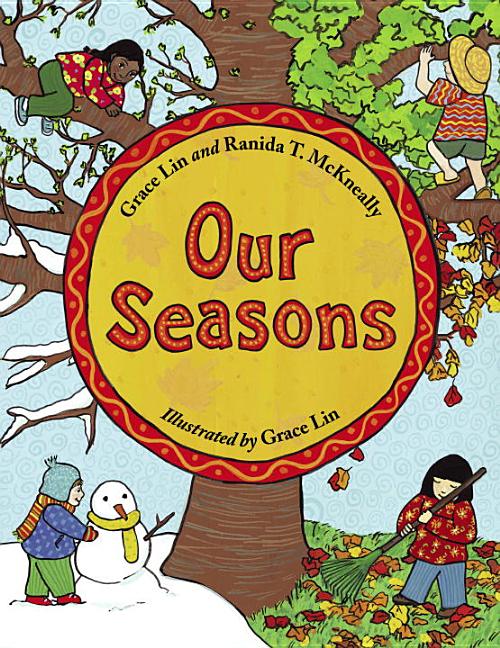
Book Resume
for Our Seasons by Ranida T. McKneally and Grace Lin
Professional book information and credentials for Our Seasons.
4 Professional Reviews
1 Book Award
Selected for 2 State/Province Lists
See full Book Resume
on TeachingBooks
Grace Lin and Ranida T. McKneally’s book of information goes far beyond a mere ...read more
- School Library Journal:
- K - Grade 2
- Booklist:
- Grades 1 - 3
- TeachingBooks:*
- Grades PK-4
- Word Count:
- 1,677
- ATOS Reading Level:
- 4.6
- Genre:
- Poetry
- Picture Book
- Year Published:
- 2006
4 Subject Headings
The following 4 subject headings were determined by the U.S. Library of Congress and the Book Industry Study Group (BISAC) to reveal themes from the content of this book (Our Seasons).
4 Full Professional Reviews
The following unabridged reviews are made available under license from their respective rights holders and publishers. Reviews may be used for educational purposes consistent with the fair use doctrine in your jurisdiction, and may not be reproduced or repurposed without permission from the rights holders.
Note: This section may include reviews for related titles (e.g., same author, series, or related edition).
From Cooperative Children's Book Center (CCBC)
Grace Lin and Ranida T. McKneally’s book of information goes far beyond a mere recitation of facts about the seasons, offering an engaging question-and-answer format combined with poetry. Organized by season, information is presented in response to questions that relate to typical attributes of each time of year. Beginning in autumn, questions posed include “What is the wind?” and “Why do leaves change color?” Winter brings responses to “What is snow?” and “Why do my cheeks turn red in the cold?” There are three questions for each season, with each two-page spread devoted to one question and its reply. These are accompanied by an inviting illustration featuring one or more of a diverse group of children, and a haiku on each subject. (“Owen’s cheeks turn red / From the cold lipstick kisses / Given by the wind.”) (Ages 4–8)
CCBC Choices 2007 © Cooperative Children's Book Center, Univ. of Wisconsin - Madison, 2007. Used with permission.
From Horn Book
January 1, 2007
The authors introduce young readers to the four seasons, combining haiku ("A lacy curtain / Has been drawn on the window / By the frost artist") with scientific questions ("Why is there frost on the window?") and answers, some of which may require more explanation. The clean design and gouache illustrations nicely reflect the changing palette of each season. Glos.
(Copyright 2007 by The Horn Book, Incorporated, Boston. All rights reserved.)
From School Library Journal
August 1, 2006
K-Gr 2 -Following a brief explanation of the science behind the seasons, Lin takes readers from autumn to summer, pairing haiku verses on one page with explanations of seasonal changes on the other. For autumn, for example, the text answers the questions, -What makes the wind? - -Why do leaves change color? - and -Why do I see my breath? - Further pairings address frost, suntans, thunderstorms, and pollination, among others. The simple haiku provide an accessible foray into poetry for the youngest readers and, for the most part, the scientific explanations follow suit. While the initial explanation of the Earth -s revolution around the sun might have benefited from a more illustrative diagram, the title ultimately delivers. The gouache illustrations have plenty of child appeal and effectively tie together the poetry and the facts. A welcome addition to any collection in need of seasonal titles." -Jill Heritage Maza, Conn Elementary, Raleigh, NC"
Copyright 2006 School Library Journal, LLC Used with permission.
From Booklist
July 1, 2006
Gr. 1-3. Less workmanlike than Gail Gibbons' " The Reasons for the Seasons "(1995), this attractive picture book demystifies seasonal changes in a question-and-answer format. Each spread's boldfaced head-scratcher ("Why do my cheeks turn red in the cold?" "What makes a thunderstorm?") receives two smoothly written paragraphs of explanation; an energetic, arrestingly patterned painting featuring one of the book's four child characters; and an interpretive haiku ("Lily hears thunder. / 'You don't have to yell!' she calls. / Still, the sky grumbles"). An excellent opening and closing entry connects the earth's tilt with seasonal conditions around the world. The organization is a bit awkward. Although questions are grouped by season, they often apply more broadly, and some entries would have benefited from diagrams. Even so, children won't escape learning a thing or two about the processes described, and many teachers will find inspiration for language-arts projects in the haiku component. For a seasonal celebration in which poetry comes front and center, suggest Bobbi Katz's " Once around the Sun "(2006).(Reprinted with permission of Booklist, copyright 2006, American Library Association.)
1 Book Awards & Distinctions
Our Seasons was recognized by committees of professional librarians and educators for the following book awards and distinctions.
2 Selections for State & Provincial Recommended Reading Lists
Our Seasons was selected by educational and library professionals to be included on the following state/provincial reading lists.
United States Lists (2)
Wisconsin
- 2013-2014 Read On Wisconsin Book Club, Grades K-2
- 2013-2014 Read On Wisconsin Book Club, Grades PK-12
Preview Digital Book
Explore Our Seasons on Marketplace. Access requires OverDrive Marketplace login.
This Book Resume for Our Seasons is compiled from TeachingBooks, a library of professional resources about children's and young adult books. This page may be shared for educational purposes and must include copyright information. Reviews are made available under license from their respective rights holders and publishers.
*Grade levels are determined by certified librarians utilizing editorial reviews and additional materials. Relevant age ranges vary depending on the learner, the setting, and the intended purpose of a book.
Retrieved from TeachingBooks on February 02, 2025. © 2001-2025 TeachingBooks.net, LLC. All rights reserved by rights holders.


 CCBC Choices, Selection, 2007
CCBC Choices, Selection, 2007
